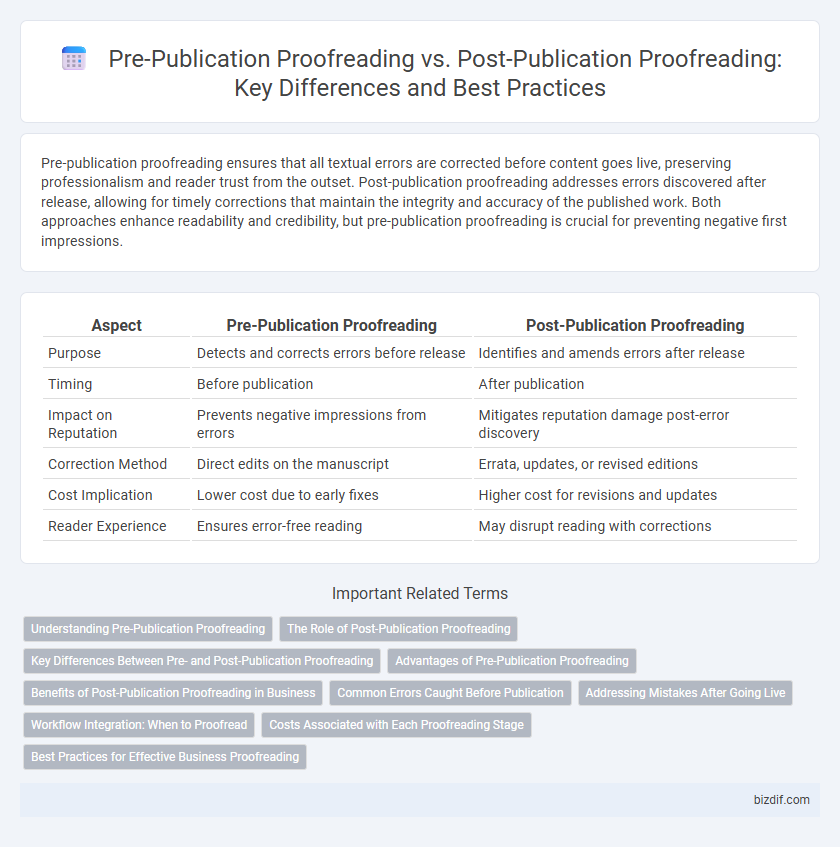Pre-publication proofreading ensures that all textual errors are corrected before content goes live, preserving professionalism and reader trust from the outset. Post-publication proofreading addresses errors discovered after release, allowing for timely corrections that maintain the integrity and accuracy of the published work. Both approaches enhance readability and credibility, but pre-publication proofreading is crucial for preventing negative first impressions.
Table of Comparison
| Aspect | Pre-Publication Proofreading | Post-Publication Proofreading |
|---|---|---|
| Purpose | Detects and corrects errors before release | Identifies and amends errors after release |
| Timing | Before publication | After publication |
| Impact on Reputation | Prevents negative impressions from errors | Mitigates reputation damage post-error discovery |
| Correction Method | Direct edits on the manuscript | Errata, updates, or revised editions |
| Cost Implication | Lower cost due to early fixes | Higher cost for revisions and updates |
| Reader Experience | Ensures error-free reading | May disrupt reading with corrections |
Understanding Pre-Publication Proofreading
Pre-publication proofreading is the critical process of reviewing a manuscript before it is printed or uploaded online, ensuring errors in grammar, spelling, punctuation, and formatting are corrected to maintain professionalism and readability. This stage significantly reduces the risk of costly revisions and reputational damage by catching mistakes early in the publishing workflow. Understanding pre-publication proofreading helps authors and publishers produce polished, error-free content that meets industry standards and reader expectations.
The Role of Post-Publication Proofreading
Post-publication proofreading plays a crucial role in maintaining the accuracy and credibility of published content by identifying and correcting errors that were missed before release. This process ensures that digital and print materials stay credible and up-to-date, enhancing the reader's trust and the publication's reputation. Continuous post-publication review helps catch typographical mistakes, factual inaccuracies, and formatting issues that impact the overall quality of academic papers, articles, and books.
Key Differences Between Pre- and Post-Publication Proofreading
Pre-publication proofreading focuses on identifying and correcting errors before a document is released, ensuring accuracy and consistency in grammar, spelling, and formatting. Post-publication proofreading addresses errors discovered after release, often involving corrections that maintain the integrity of the published material without altering the original context. The key differences lie in timing, purpose, and the extent to which changes can be made without affecting the document's public reception and credibility.
Advantages of Pre-Publication Proofreading
Pre-publication proofreading ensures error-free content before dissemination, enhancing credibility and reader trust. Catching mistakes early reduces costly revisions and reputational damage after release. This process optimizes clarity, consistency, and overall quality, directly impacting audience engagement and professional standards.
Benefits of Post-Publication Proofreading in Business
Post-publication proofreading enables businesses to identify and correct errors that were missed before release, enhancing brand credibility and customer trust. It also offers valuable insights into audience reception and content effectiveness, guiding future communication strategies. Continuous error correction through post-publication proofreading helps maintain a polished and professional public image over time.
Common Errors Caught Before Publication
Pre-publication proofreading effectively catches common errors such as typographical mistakes, grammatical inconsistencies, and formatting issues before the content reaches readers, ensuring polished and professional output. This stage addresses factual inaccuracies and citation errors, helping maintain credibility and preventing costly corrections after release. Post-publication proofreading typically focuses on user-reported errors but lacks the proactive error prevention that pre-publication review provides.
Addressing Mistakes After Going Live
Pre-publication proofreading ensures errors are corrected before the content goes live, minimizing the risk of publishing mistakes that could damage credibility. Post-publication proofreading addresses mistakes discovered after release, allowing for timely corrections but potentially impacting reader trust and search engine rankings. Effective post-publication proofreading often involves rapid updates and transparent communication to maintain content accuracy and audience confidence.
Workflow Integration: When to Proofread
Pre-publication proofreading integrates seamlessly into the editorial workflow by catching errors before printing or digital release, ensuring content accuracy and consistency at the earliest stage. Post-publication proofreading occurs after release and is essential for identifying issues missed initially or for correcting evolving digital content, but it can be more disruptive and costly. Effective workflow integration prioritizes pre-publication proofreading to minimize errors, with post-publication proofreading serving as a corrective measure for ongoing quality assurance.
Costs Associated with Each Proofreading Stage
Pre-publication proofreading typically incurs higher upfront costs due to extensive editing required to ensure error-free content before printing or digital release. Post-publication proofreading often involves corrective expenses, such as issuing errata or digital updates, which can be costlier and impact brand reputation. Investing in thorough pre-publication proofreading minimizes the risk of expensive corrections and enhances overall content quality.
Best Practices for Effective Business Proofreading
Pre-publication proofreading ensures errors are caught before content reaches the audience, safeguarding brand reputation and enhancing clarity. Post-publication proofreading allows for the correction of overlooked mistakes, maintaining ongoing professionalism in digital and print materials. Employing a systematic checklist and multiple review stages optimizes accuracy and consistency in business communications.
Pre-Publication Proofreading vs Post-Publication Proofreading Infographic

 bizdif.com
bizdif.com